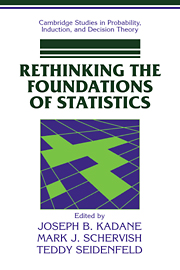Book contents
- Frontmatter
- Contents
- Introduction
- PART 1 DECISION THEORY FOR COOPERATIVE DECISION MAKING
- PART 2 THE TRUTH ABOUT CONSEQUENCES
- PART 3 NON-COOPERATIVE DECISION MAKING, INFERENCE, AND LEARNING WITH SHARED EVIDENCE
- 3.1 Subjective Probability and the Theory of Games
- 3.2 Equilibrium, Common Knowledge, and Optimal Sequential Decisions
- 3.3 A Fair Minimax Theorem for Two-Person (Zero-Sum) Games Involving Finitely Additive Strategies
- 3.4 Randomization in a Bayesian Perspective
- 3.5 Characterization of Externally Bayesian Pooling Operators
- 3.6 An Approach to Consensus and Certainty with Increasing Evidence
- 3.7 Reasoning to a Foregone Conclusion
- 3.8 When Several Bayesians Agree That There Will Be No Reasoning to a Foregone Conclusion
- Index of Names
- Subject Index
3.7 - Reasoning to a Foregone Conclusion
Published online by Cambridge University Press: 05 June 2012
- Frontmatter
- Contents
- Introduction
- PART 1 DECISION THEORY FOR COOPERATIVE DECISION MAKING
- PART 2 THE TRUTH ABOUT CONSEQUENCES
- PART 3 NON-COOPERATIVE DECISION MAKING, INFERENCE, AND LEARNING WITH SHARED EVIDENCE
- 3.1 Subjective Probability and the Theory of Games
- 3.2 Equilibrium, Common Knowledge, and Optimal Sequential Decisions
- 3.3 A Fair Minimax Theorem for Two-Person (Zero-Sum) Games Involving Finitely Additive Strategies
- 3.4 Randomization in a Bayesian Perspective
- 3.5 Characterization of Externally Bayesian Pooling Operators
- 3.6 An Approach to Consensus and Certainty with Increasing Evidence
- 3.7 Reasoning to a Foregone Conclusion
- 3.8 When Several Bayesians Agree That There Will Be No Reasoning to a Foregone Conclusion
- Index of Names
- Subject Index
Summary
ABSTRACT
When can a Bayesian select an hypothesis H and design an experiment (or a sequence of experiments) to make certain that, given the experimental outcome(s), the posterior probability of H will be greater than its prior probability? In this chapter we discuss an elementary result that establishes sufficient conditions under which this reasoning to a foregone conclusion cannot occur. We illustrate how when the sufficient conditions fail, because probability is finitely but not countably additive, it may be that a Bayesian can design an experiment to lead his/her posterior probability into a foregone conclusion. The problem has a decision theoretic version in which a Bayesian might rationally pay not to see the outcome of certain cost-free experiments, which we discuss from several perspectives. Also, we relate this issue in Bayesian hypothesis testing to various concerns about “optional stopping.”.
INTRODUCTION
In a lively (1962) discussion of some foundational issues, several noted statisticians, especially L. J. Savage, focused on the controversy of whether an experimenter's stopping rule is relevant to the analysis of his or her experimental data. Savage wrote (1962, p. 18):
The [likelihood] principle has important implications in connection with optional stopping. Suppose the experimenter admitted that he had seen 6 red-eyed flies in 100 and had then stopped because he felt that he had thereby accumulated enough data to overthrow some popular theory that there should be about 1 per cent red-eyed flies. […]
- Type
- Chapter
- Information
- Rethinking the Foundations of Statistics , pp. 349 - 368Publisher: Cambridge University PressPrint publication year: 1999

